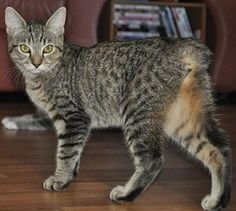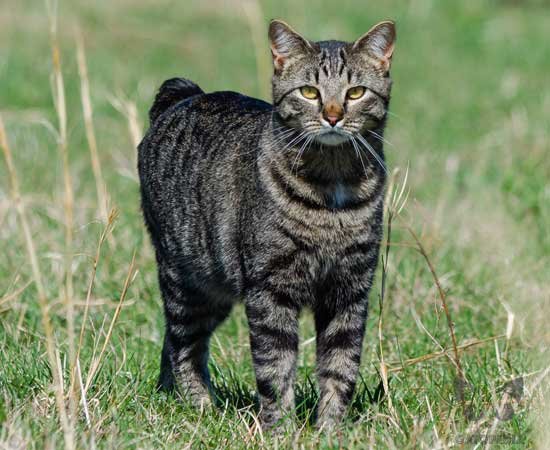Manx
The Manx cat is renowned for its distinctive physical traits that set it apart from other feline breeds. Foremost among these characteristics is the varied tail length, which can range from completely tailless, known as a “rumpie,” to long-tailed versions. This variation arises from a genetic mutation that affects tail development, leading to the classification of Manx cats into categories like short-tailed and long-tailed. This unique tail configuration is a defining feature of the breed, captivating many cat enthusiasts.

In addition to tail length, the Manx showcases a robust, muscular build. These cats typically possess a round, broad head coupled with prominent cheekbones and large, expressive eyes that contribute to their overall allure. Their body is compact yet powerful, leading to an agile, graceful posture. A distinctive aspect of their physicality is the strength of their hind legs, which not only supports their sturdy frame but also facilitates a unique gait. This pronounced movement resembles a rabbit’s hop, further highlighting their playful and lively nature.
The coat of the Manx can vary significantly, encompassing both longhaired and shorthaired varieties. The texture can range from plush to soft, providing an inviting tactile experience. Coat colors also exhibit a wide spectrum – common shades include white, black, orange, and tortoiseshell, often with intricate patterns. Despite their charming appearance, prospective owners should be aware of potential health issues related to the breed’s genetic traits. These may include spinal malformations and other conditions stemming from the tailless gene. Thus, responsible breeding practices become crucial to ensure the continued health and preservation of this captivating breed.

Personality
The Manx cat breed is renowned for its distinctive personality traits, which contribute significantly to its popularity among feline enthusiasts. One of the most prominent characteristics of the Manx cat is its friendly demeanor. These cats are known for their affectionate nature, often forming strong bonds with their human companions. Their propensity for social interaction makes them an ideal choice for families, as they tend to thrive in environments where they receive ample attention and affection.
Social awareness is another defining trait of the Manx cat. They are not only comfortable around their human families but also exhibit a keen ability to get along with other pets. This sociability makes them adaptable, allowing them to integrate seamlessly into multi-pet households. Manx cats often display a curious and interactive behavior, seeking out attention and engagement from their owners. Their playful personality manifests through active playtime, whether it involves chasing toys or engaging in games that stimulate their minds and bodies.
Trainability is yet another area where the Manx cat excels. Their intelligence, coupled with their enthusiastic approach to learning, allows them to pick up various commands and tricks with relative ease. This trait can be especially advantageous for families looking to encourage positive behavior and ensure a harmonious household environment. However, it is essential to note that the behavior of Manx cats can vary based on individual personalities and the dynamics of the household. Factors such as the number of family members, presence of children, and other pets may influence their behavior, leading to uniquely engaging interactions that reflect their adaptable nature.
Origins
The Manx cat breed has a captivating history that can be traced back to the Isle of Man, a small island located in the Irish Sea. The origins of this distinct breed are shrouded in mystery, characterized by various theories that attempt to explain the genetic mutation responsible for its iconic taillessness. One prevalent theory suggests that the breed developed from domestic cats originally brought to the island by seafarers, where a natural mutation arose leading to the absence of a tail. Over time, this trait became prominent within the breed, creating the tailless Manx cat many enthusiasts recognize today.

Another explanation for the breed’s unique characteristics points to a population of feral cats on the Isle of Man, which existed in isolation from mainland influences. This geographical seclusion allowed specific genetic traits to flourish, resulting in a cat with not just taillessness, but also a robust body, a round head, and a playful disposition. The Manx cat’s development in a confined environment helped cement its distinct identity, making it a cultural icon unique to the region.
Care of the Manx cat
Caring for a Manx cat requires a comprehensive approach that addresses their specific needs and characteristics. First and foremost, a well-balanced diet plays a crucial role in maintaining your Manx’s health. High-quality cat food enriched with essential nutrients, vitamins, and minerals is vital. Given their predisposition to certain genetic health issues, it is advisable to consult your veterinarian for recommendations tailored specifically to your cat’s age, weight, and activity level. This will help ensure they receive the necessary components for both physical health and longevity.
Additionally, grooming is an important aspect of caring for Manx cats. Their short-haired variety requires less maintenance than their long-haired counterparts, but regular brushing will help reduce shedding and minimize hairballs. On the other hand, long-haired Manx cats benefit from more frequent grooming sessions to prevent mats and tangles. Furthermore, establishing a routine that includes checking their ears and trimming their nails is essential for overall hygiene.
Veterinary check-ups are crucial for Manx cats, particularly due to their propensity for certain inherited conditions such as spinal defects and urinary tract issues. Regular examinations can help identify potential health risks early, enabling intervention before problems escalate. Owners are encouraged to stay vigilant about behavioral changes or signs of discomfort, as these can be indicative of underlying health issues.
In terms of exercise and mental stimulation, Manx cats are active and intelligent. Engage them with interactive toys, scratching posts, and climbing structures to promote physical activity. Regular playtime is pivotal not only for physical health but also for mental well-being. Creating a stimulating environment with plenty of opportunities for exploration and play fosters a fulfilling lifestyle as beloved companions.
Helath
The Manx cat is generally a healthy breed but is prone to spinal issues due to its genetic mutation, which can cause Manx Syndrome affecting the spine, bowels, and bladder. Regular vet checkups, a balanced diet, and proper exercise help maintain their overall well-being.
Nutrition
The Manx cat requires a balanced diet rich in high-quality protein, essential fatty acids, and taurine to support its muscular build and overall health. Grain-free or limited-ingredient cat food is ideal to prevent digestive issues, as some Manx cats may have sensitive stomachs. Proper hydration and portion control help maintain a healthy weight and prevent obesity-related problems. Consult a vet for personalized dietary recommendations.
Cleanliness
The Manx cat is a naturally clean breed with minimal grooming needs. Its dense double coat benefits from weekly brushing to reduce shedding and prevent matting. These cats are meticulous self-groomers, requiring occasional ear and dental care for optimal hygiene. Their short or long fur varieties are both easy to maintain, making the Manx a great choice for owners seeking a low-maintenance pet.
Best cat breeds for kids
The Manx cat is a friendly, playful, and affectionate breed, making it one of the best cat breeds for kids. Known for its signature tailless appearance, the Manx is intelligent, social, and enjoys interactive play. Its gentle temperament and strong bond with families make it a perfect pet for children. Plus, their playful nature keeps kids entertained!
People who have seen this breed have also visited…
In this section you can find completely detailed information about the breed of your cat.
